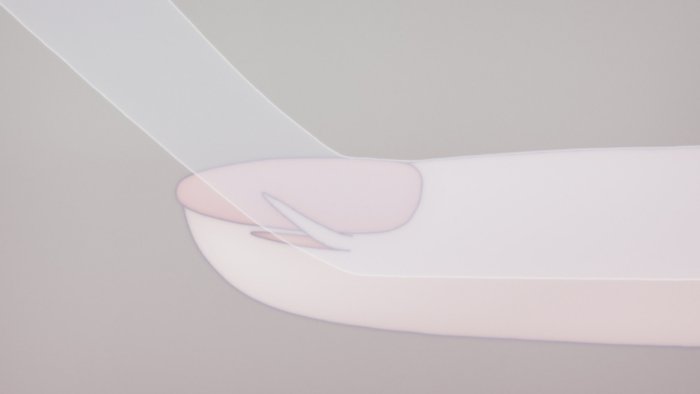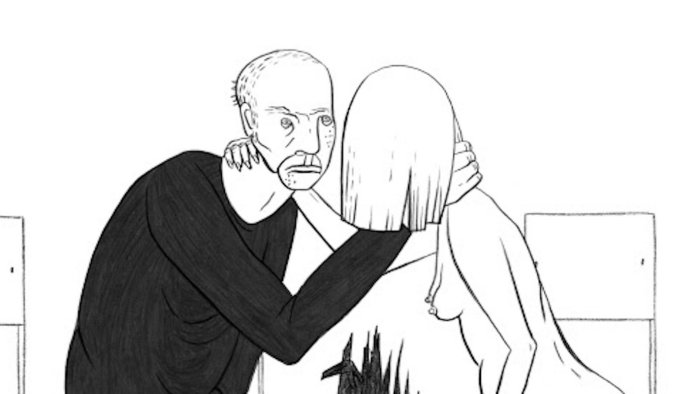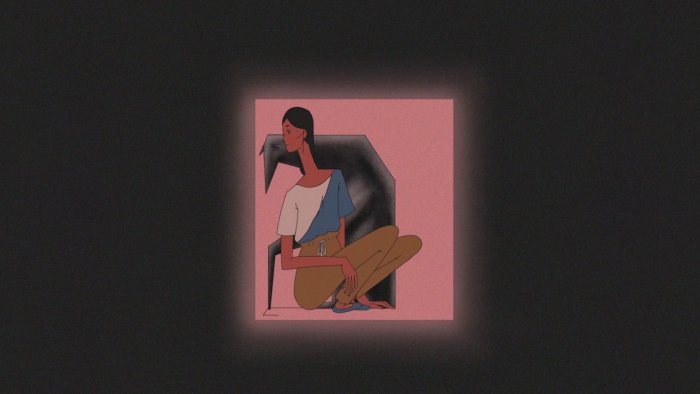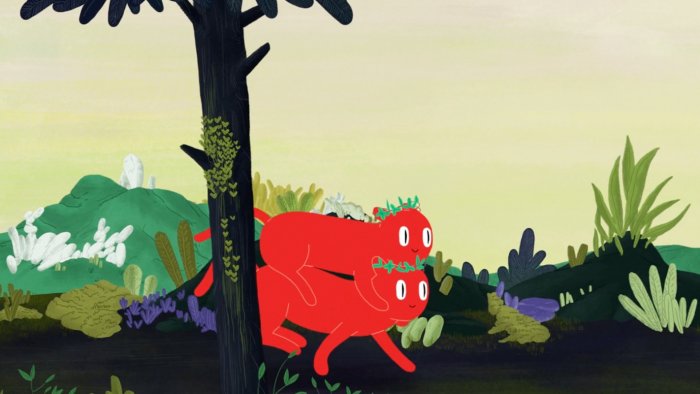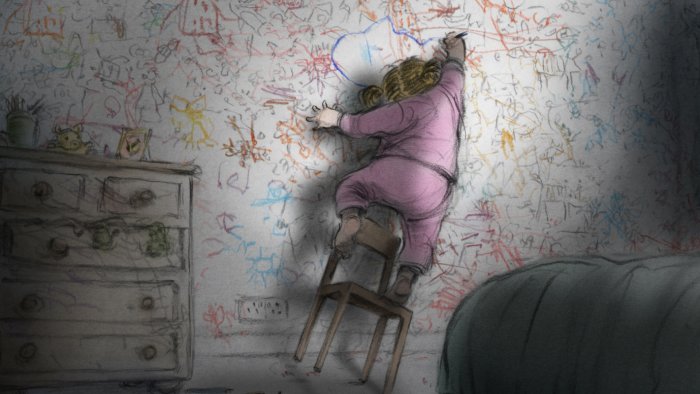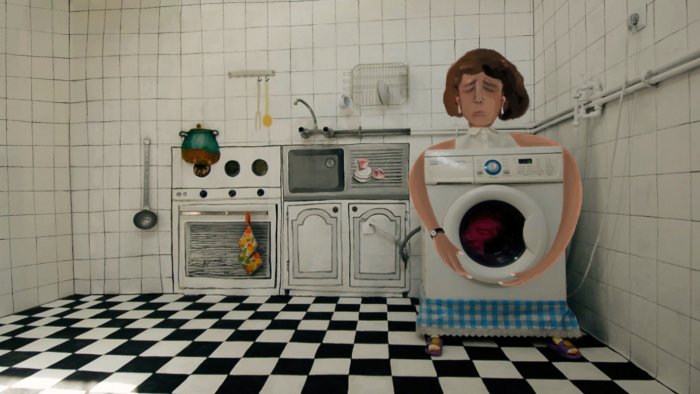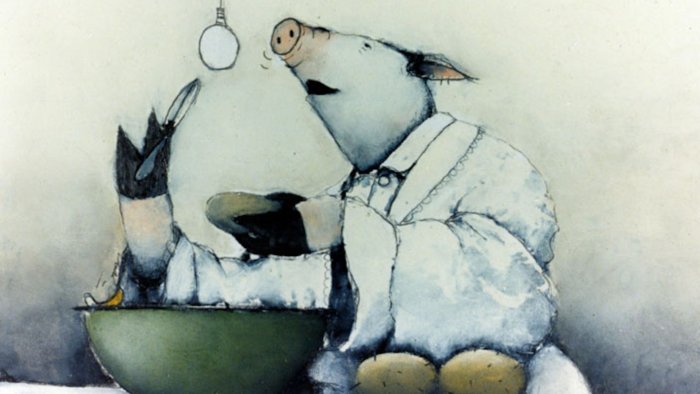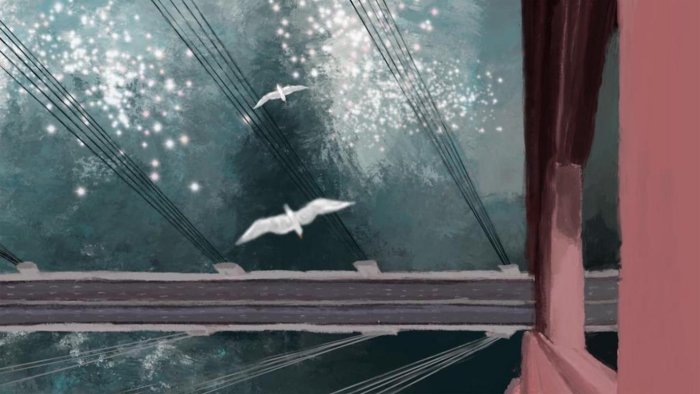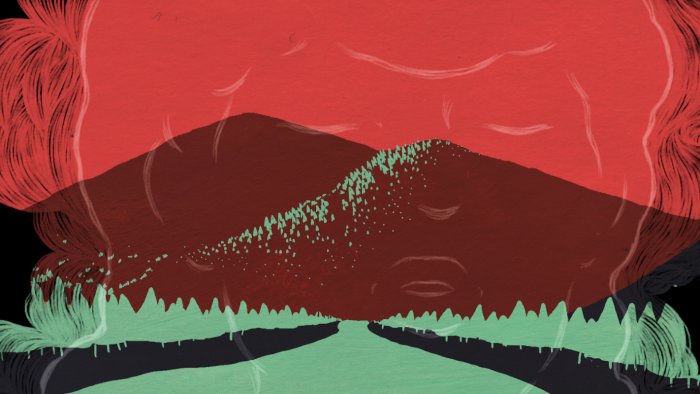Fantoche 2021, starting with Réka Bucsi
A personal survey on animation after the experience at the 2021 edition of the International Animation Film Festival Fantoche in Baden. Focus on Réka Bucsi, International Competition, and the curated section «Un monde fragile». By Giuseppe Di Salvatore
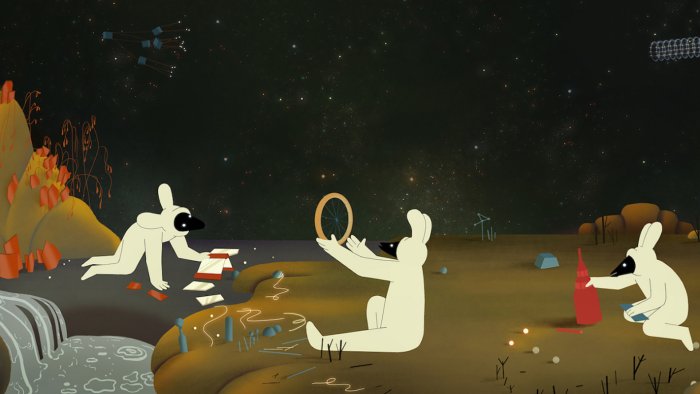
«I like a sort of flatness» – Réka Bucsi says during her masterclass at the International Animation Film Festival Fantoche in Baden. It is the first event that I attended at the festival, and the different aspects of her art provided me with the main threads that I would like to follow, navigating back now through the different short films from the International Competition and the curated section «Un monde fragile». Flatness: a modernist element that intrinsically pertains to animation? Not necessarily - at least today - if we consider the magical world of After Effects and the digital possibilities available to young animators. A 2D aesthetic of simplicity is now a choice, and can also appear to be inspired by a nostalgic vintage touch. Réka was referring to her graduation film Symphony n. 42 (see the FILM), which narratively also prefers stylisation and minimalism. The series of closed scenes follows the simple pattern of displaying a situation that leads to, or which intervenes in, a slightly surprising happening. The free space that is opened by abstraction is then fulfilled with unexpected associations (please, don’t call them surrealist!) – in each scene, and between the scenes too. The fantastic world of animation also delivers to an eventually even more fantastic work of the audience.
The modernist thread of animation
I didn’t watch Signe Baumane’s films (Retrospective) again, but – even if not to the Latvian artist - this aesthetic certainly fits two of the most wonderful works that I saw this year at Fantoche: Yoriko Mizushiri’s Anxious Body (here the TRAILER) and Marta Pajek’s III (Impossible Figures and Other Stories) (here the TRAILER). Here the extreme reduction in the drawing conveys a sort of “drama of the line” (just like in Osvaldo Cavandoli’s infamous La Linea), where abstraction creates momentary moments of annihilation/liberation of figuration, which lead to the experience of the birth/rebirth of figures, over and over. Less is definitely more, a caress can let us better experience touch than hard pressure, and through a minimal grammar both films are able to awaken a sensuality that almost aches. In comparison, Jinghui Gao’s noteworthy Folding Land rather seems to be an exercise (on the theme of the urbanity/countryside divide), whereas Paulina Ziolkowska’s Bless You! (see the FILM) and Frédéric Doazan’s Windshriek (see the FILM) are able to use simple concepts – respectively, the sneeze and the action of wind – in order to display an escalation in abstraction, up to exploring new territories of imagination (please, don’t call them surrealist!). I ended this short journey into minimalism with two films that revisit an extremely reduced graphic alphabet still realising the maximum of expression and narrativity respectively: Géza M. Tóth’s Mitch Match (#09) (here the TRAILER) and Simon Schnellmann’s To the Last Drop (here the TRAILER).
Cosmic isolation
Am I searching for poetry in animation films? While I am asking myself this question, Réka Bucsi speaks about career strategies - for example how films can (also) be thought as a kind of pitching for the next films - and I am reminded of how the lyrical in animation is always bound to patience and hard working. However, Réka’s enthusiasm about the team work in the exceptional and secluded atmosphere of the community of animators in Viborg (Denmark) triggered another theme in my mind. Her films often play with a particular kind of exceptionality and seclusion, one that is generated through the creation of “cosmic” environments – which is explicit in her last Solar Walk (here the TRAILER), but more subtle in the other films, insofar as the cosmic element is not declared as central theme but appears as an unexpected one. Another dimension of abstraction is at stake: the isolation of the stories from their usual context of meaning. If animated worlds already tend to deviate from mimetic representation, “cosmic animation” underlines the metaphysical, non-naturalist potentialities of what is animated.
Staging fragility
With respect to those potentialities, I think back to Réka Anna Szakàly’s beautiful Reduction (here the TRAILER). On the one hand, Reduction’s clearly narrative structure is immersed in a post-apocalyptic environment, thereby creating a spatial isolation that allows the interiority of the main character to emerge. In this way the Hungarian filmmaker can draw this mysterious-then-abstract space of the soul where fear and attraction join together. On the other hand, abstract-then-mysterious is the world made of old coloured papers (actually vintage book covers) in Lei Lei’s This Is Not a Time to Lie (see the FILM). His little characters are lost in compact fields of colours, the mixture of joyfulness and lostness providing us with an existential flavour. Quite appropriate then was the choice of the curators Doris Cleven and Oswald Iten to include this film in the section «Un monde fragile». All these strategies of isolation can favour fragility – be it created through formal solutions, like in the Chinese short film, or displayed in the story, as in Duke Johnsons and Charlie Kaufmann’s Anomalisa (see Filmexplorer's review). In this context, I want to mention Malte Stein’s Ding (here the TRAILER), one of the most disquieting films I saw at Fantoche this year, in which both the characters and their deeds are completely isolated, thus intensifying the obsessive atmosphere typical of nightmares.
Exploring the territory of ambivalence
Discussing her Love (see the FILM), the moderator of Réka Bucsi’s masterclass resumed her style of a mixture of alienation and humour. I had previously written in my notebook: mixture of playfulness and violence. As for abstraction, minimalism, or isolation, we have here something typical of animation films. The traditional entertainment version of this mixture can well be exemplified by Jonas Geirnaert’s Flatlife (see the FILM), a divertissement that uses the “making fun of accidents” as the drive for a combinatory game. On the contrary, Réka’s films seem to radicalise both playfulness and violence, making of their marriage the occasion to create a new territory where enchantment and disenchantment coalesce. Through completely different means, it is precisely this new territory of ambivalence that I find in Joanna Quinn’s excellent Affairs of the Art (here the TRAILER). With British humour and a sort of vintage drawing style that recalls Wilhelm Busch’s illustrations, the path that leads from drama to fun is the same as the one that leads from fun to drama. Following the autobiographical stories of her character, we have a kind of duck-rabbit experience that leaves us with a bitter-sweet flavour, which is really bitter and really sweet at the same time.
The children/adult misunderstanding
This ambivalence creates the strength of Mahboobeh Kalaee’s The Fourth Wall (here the TRAILER). The child perspective provides us with a playful and light tonality, which quickly reveals itself as a fragile enchantment that is constantly confronted with the hardship of claustrophobic familiar tensions – the mirror of an entire society. This is not a film “for children”, neither is it a film “for adults”. Drama is not anesthetised for the sake of children and neither is the child perspective only instrumental to highlighting dramatic topics, thus these kind of films liberate us from what I would call the “children/adult misunderstanding” of animation films. There is an analogy between making a film for children or for adults, and, respectively, neutralising violence through playfulness or using playfulness to convey violence. In this way, the powerful ambivalence between playfulness and violence gets lost.
Strange animals or gentle monsters?
Another testing ground for this ambivalence is the role of animals in animation films. They are not only a projection surface for modelling different (human) types or characters – such as in Denisa Grimmová and Jan Bubenícek’s Even Mice Belong in Heaven (here the TRAILER), a slightly moralist story but one which deserves much praise for the unbridled imagination. Animals also embody a specific Otherness, which can be either domesticated or completely alienated. An alternative to this either/or situation would be keeping both the familiar and alien features of animals. They are gentle monsters but at the same time strange animals. In this regard, Felix Colgrave’s Throat Notes (see the FILM) and Dante Zaballa and Osian Efnisien’s Curious World of Animals (see the FILM) are perfect examples of ambivalence, where – also formally – the joy of colours leaves room for the brutality and the absurdity of the scenes respectively.
Films do not need to be explained
The characters are animals, but the focus of the film is certainly elsewhere. I am speaking of one of the most convincing short films from the section «Un monde fragile»: Wendy Tilby and Amanda Forbis’ When the Day Breaks (see the FILM). The story, told in a classical narrative style, could appear as the main focus, but it actually reveals itself to be a kind of long detour that aims at sketching a subtle sentimental cracking within the solidity of habits in urban life (something similar to what Nicolas Keppens achieves with his story in Easter Eggs (see the FILM), but which is more conventional in the storytelling and the image). The Canadian duo uses animals and a story in order to explore a feeling of fragility that would be otherwise difficult to grasp. «With films I can express something that goes beyond dialogues»; «I try to avoid explanatory aspects, and rather get the general atmosphere». I come back to Réka Bucsi’s words to highlight another typical feature of animation films, the absence of dialogues, which hints positively at the virtues of image and sound in her films or in films like When the Day Breaks and - moreover - is specifically meant to avoid the redundancy of explanation in film – a general plague that is certainly not limited to animation films… From this point of view, Marine Blin’s Ce qui résonne dans le silence (see the FILM) is as fascinating for the “general atmosphere” that it expresses as it is burdened with too many words (voice over). I found a better balance in Franck Dion’s Une tête disparait (see the FILM), where the specific possibilities of animation are perfectly exploited in order to make us experience - from the inside - the amnesia of people suffering from Alzheimer’s disease; or in Ayce Kartal’s I Gotta Look Good for the Apocalypse (here the TRAILER), that entirely invests in the juxtaposition of two different visual aesthetics and techniques in order to get its own “general atmosphere”. Concerning the self-explanatory visual research, I would also like to mention Sophie Racine’s Rivages (here the TRAILER) and Toby Auberg’s Pile (see the FILM).
The natural opacity of animation films
Am I searching for poetry in animation films? My question rises again, while Réka Bucsi invokes the label of “experimental narrative” for her films, as if she should legitimate her eventual use of fragmentation or non-linear storytelling. Like Jonas Mekas against the label of “experimental film”, I would equally have reservations about the label of “experimental narrative”, not because films like Réka’s ones should not be called experimental but because the expression suggests something more than normal narrative, whereas it is non-experimental narratives that actually lack something. What exactly? With their simplicity they push the audience towards a passive reception of the film, subsequently imposing the narrative layer at the expense of the visual and/or the sound layer of the film. Very well executed films like Michaela Pavlatova’s My Sunny Maad (here the TRAILER) or Aurel’s Josep (here the TRAILER), for example, are provided with such an easy and self-imposing narrative that we will be completely absorbed in the story and forget that we are looking at animated drawings. Animation becomes transparent. What non-experimental narratives lack is opacity, and what should an animation film without opacity – which means that it does not exploit the specificity of its labour-demanding medium – be for? It is certainly more challenging to follow, but Felix Dufour-Laperrière’s wonderful Archipel (see Filmexplorer's review) is conspicuous by its absence of transparency, by its fragmented narrative which goes together with the use of different visual layers.
The haiku attraction
An alternative interpretation: let’s look at a fragmented narrative as a linear storytelling. Result: you will discover silences and pauses as new protagonists of the film. Here I eventually find one specific feature of the poetry I am searching in animation films. If Réka Bucsi’s aesthetic is particularly attractive to me it is probably because of the void spaces of homogeneous colour, of the muted characters, of the suspensions or pauses in the narration. Speaking of her Symphony n. 42, she mentions the form of the haiku, short, condensed, where any word is an accomplice to the wordless world of meditation and silence. Something that I track down in Marta Gennari’s simple Bigoudis (here the TRAILER), or in Mathieu Georis’ Ten, Twenty, Thirty, Forty, Fifty Miles a Day (here the TRAILER), where it is less the story, and more the moments of suspension in it that are especially relevant. Abstraction, isolation, ambivalence: they all cooperate to create a poetic suspension that doesn’t necessarily have to be oriented and become suspense. What if poetic suspension would be the secret magic formula of animation films?
